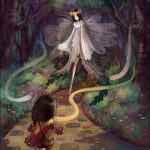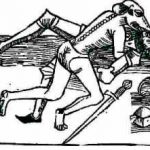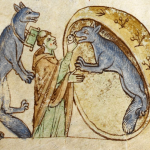Slovakian household tale given by T. T. Hanush in the third volume of Zeitschrift für Deutsche Mythologie.
"There was once a father, who had nine daughters, and they were all marriageable, but the youngest was the most beautiful. The father was a were-wolf. One day it came into his head: ‘What is the good of having to support so many girls?’ so he determined to put them all out of the way.
"He went accordingly into the forest to hew wood, and he ordered his daughters to let one of them bring him his dinner. It was the eldest who brought it.
"’Why, how come you so early with the food?’ asked the woodcutter.
"’Truly, father, I wished to strengthen you, lest you should fall upon us, if famished!’
"’A good lass! Sit down whilst I eat.’ He ate, and whilst he ate he thought of a scheme. He rose and said: I My girl, come, and I will show you a pit I have been digging.’
"’And what is the pit for? ‘
"’That we may be buried in it when we die, for poor folk will not be cared for much after they are dead and gone.’
"So the girl went with him to the side of the deep pit. ‘Now hear,’ said the were-wolf, ‘you must die and be cast in there.’
"She begged for her life, but all in vain, so he laid hold of her and cast her into the grave. Then he took a great stone and flung it in upon her and crushed her head, so the poor thing breathed out her soul. When the were-wolf had done this he went back to his work, and as dusk came on, the second daughter arrived, bringing him food. He told her of the pit, and brought her to it, and cast her in, and killed her as the first. And so he dealt with all his girls up to the last. The youngest knew well that her father was a were-wolf, and she was grieved that her sisters did not return; she thought, ‘Now where can they be? Has my father kept them for companionship; or to help him in his work?’ So she made the food which she was to take him, and crept cautiously through the wood. When she came near the place where her father worked, she heard his strokes felling timber, and smelt smoke. She saw presently a large fire and two human heads roasting at it. Turning from the fire, she went in the direction of the axe-strokes, and found her father.
"See,’ said she, ‘father, I have brought you food.’
"That is a good lass,’ said he. ‘Now stack the wood for me whilst I eat.’
"’But where are my sisters?’ she asked.
"’Down in yon valley drawing wood,’ he replied ‘follow me, and I will bring you to them.’
"They came to the pit; then he told her that he had dug it for a grave. ‘Now,’ said he, ‘you must die, and be cast into the pit with your sisters. ‘
"’Turn aside, father,’ she asked, ‘whilst I strip of my clothes, and then slay me if you will.’
"He turned aside as she requested, and then–tchich! she gave him a push, and he tumbled headlong into the hole he had dug for her.
"She fled for her life, for the were-wolf was not injured, and he soon would scramble out of the pit.
"Now she hears his howls resounding through the gloomy alleys of the forest, and swift as the wind she runs. She hears the tramp of his approaching feet, and the snuffle of his breath. Then she casts behind her her handkerchief. The were-wolf seizes this with teeth and nails, and rends it till it is reduced to tiny ribands. In another moment he is again in pursuit foaming at the mouth, and howling dismally, whilst his red eyes gleam like burning coals. As he gains on her, she casts behind her her gown, and bids him tear that. He seizes the gown and rives it to shreds, then again he pursues. This time she casts behind her her apron, next her petticoat, then her shift, and at last rums much in the condition in which she was born. Again the were-wolf approaches; she bounds out of the forest into a hay-field, and hides herself in the smallest heap of hay. Her father enters the field, runs howling about it in search of her, cannot find her, and begins to upset the different haycocks, all the while growling and gnashing his gleaming white fangs in his rage at her having escaped him. The foam flakes drop at every step from his mouth, and his skin is reeking with sweat. Before he has reached the smallest bundle of hay his strength leaves him, he feels exhaustion begin to creep over him, and he retires to the forest.
"The king goes out hunting every clay; one of his dogs carries food to the hay-field, which has most unaccountably been neglected by the hay-makers for three days. The king, following the dog, discovers the fair damsel, not exactly ‘in the straw,’ but up to her neck in hay. She is carried, hay and all, to the palace, where she becomes his wife, making only one stipulation before becoming his bride, and that is, that no beggar shall be permitted to enter the palace.
"After some years a beggar does get in, the beggar being, of course, none other than her were-wolf father. He steals upstairs, enters the nursery, cuts the throats of the two children borne by the queen to her lord, and lays the knife under her pillow.
"In the morning, the king, supposing his wife to be the murderess, drives her from home, with the dead princes hung about her neck. A hermit comes to the rescue, and restores the babies to life. The king finds out his mistake, is reunited to the lady out of the hay, and the were-wolf is cast off a high cliff into the sea, and that is the end of him. The king, the queen, and the princes live happily, and may be living yet, for no notice of their death has appeared in the newspaper."
This story bears some resemblance to one told by Von Hahn in his Griechische und Albanesische Märchen; I remember having heard a very similar one in the Pyrenees; but the man who flies from the were-wolf is one who, after having stripped off all his clothes, rushes into a cottage and jumps into a bed. The were-wolf dares not, or cannot, follow. The cause of his flight was also different. He was a freemason who had divulged the secret, and the were-wolf was the master of his lodge in pursuit of him. In the Bearnais story, there is nothing similar to the last part of the Slovakian tale, and in the Greek one the transformation and the pursuit are omitted, though the woman-eater is called "dog’s-head," much as an outlaw in the north of Europe was said to be wolf-headed.
It is worthy of notice in the tale of The Daughter of the Ulkolak, that the were-wolf fit is followed by great exhaustion, %note%1 and that the wolf is given clothes to tear, much as in the Danish stories already related. There does not seem to be any indication of his Laving changed his shape, at least no change is mentioned, his hands are spoken of, and he swears and curses his daughter in broad Slovakian. The fit very closely resembles that to which Skallagrim, the Icelander, was subject. It is a pity that the maid Bràk in the Icelandic tale did not fall upon her legs like the young lady in the hay.
[1. Compare this with the exhaustion following a Berserkir fit, and that which succeeded the attack








